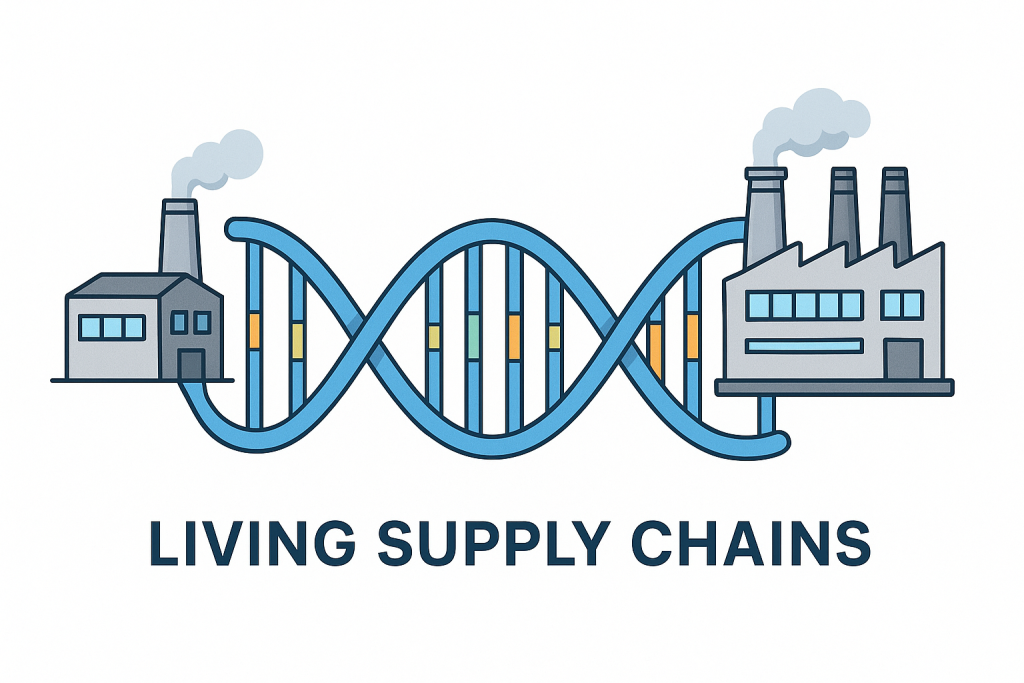Factories once moved materials around the world. Now biology moves production itself.
From Distribution to Regeneration
The supply chain was designed for distance.
For more than a century, the global economy has relied on centralized manufacturing and long-haul transport. Goods move thousands of miles before reaching consumers—burning fuel, requiring storage, and creating waste at every step.
But biology plays by different rules. Living systems make what they need, when they need it, using local resources. A tree doesn’t import leaves. A coral reef doesn’t outsource structure.
Today, synthetic biology and biomanufacturing are applying that same logic to human production—creating what’s being called living supply chains.
What Are Living Supply Chains?
They’re not about moving goods—they’re about moving growth.
A living supply chain uses programmable organisms—engineered microbes, cells, or enzymes—to produce goods on-site, near or within the communities that need them.
Instead of building factories that make and ship, we build biological systems that grow and replicate, turning carbon, nutrients, or waste into finished products.
Examples include:
- Engineered yeast brewing materials like leather or silk locally.
- Microbial bioreactors producing biofuels or fertilizers in small modular units.
- Portable biofoundries that generate vaccines or food ingredients where demand arises.
Production stops being a fixed location—it becomes a living network.
The Biological Advantage: Proximity Over Distance
Biology eliminates the middleman.
Traditional logistics depend on moving materials through warehouses, ports, and trucks. Each handoff adds cost, delay, and emissions.
Biological production, by contrast, relies on information and replication, not containers and cargo. Once a genetic design exists, it can be uploaded digitally to another site and reproduced locally using living cells.
It’s not a shipment—it’s a transfer of code.
This shift turns supply chains from physical to biological ecosystems, reducing:
- Transport emissions: Local production replaces global shipping.
- Inventory waste: Products are made on demand, not stockpiled.
- Energy costs: Microbial processes run at ambient temperature and scale naturally.
The economy becomes distributed by design.
From Warehouses to Wetware
Logistics moves from storage to synthesis.
In living supply chains, the warehouse doesn’t store materials—it stores capabilities.
A small regional bioreactor can switch from producing food proteins one week to biodegradable plastics the next, simply by changing the biological “recipe.”
That flexibility makes biological systems far more resilient to shocks—pandemics, trade disruptions, or raw material shortages. The “factory of the future” isn’t a building; it’s a programmable cell.
Local Manufacturing, Global Resilience
The global economy doesn’t have to mean global transport.
Biological logistics allow for localized self-sufficiency within a connected global framework. Think of it as cloud computing for materials: the designs are global, the production is local.
A coastal community could grow its own algae-based plastics. A hospital could synthesize drugs on-site from genetic templates. A farm could produce custom fertilizers via engineered soil microbes.
Each node in the system becomes both producer and consumer, shrinking the distance between innovation and impact.
The Economics of Living Logistics
Carbon efficiency is becoming cost efficiency.
Living supply chains introduce a new kind of economic logic: decentralized value creation. Instead of concentrating wealth and emissions in industrial hubs, biological production distributes them through communities.
Key advantages include:
- Lower capital costs: Modular bio-manufacturing units are smaller and cheaper than traditional plants.
- Circular resource use: Waste streams feed new production cycles.
- Adaptive production: Real-time genetic updates can meet changing demand.
Biology turns logistics into a flow of regeneration, not extraction.
Education for the Bio-Logistics Era
Tomorrow’s workforce must learn to manage living systems, not just machines.
Parents and educators play a critical role in preparing students for this biological economy. The next generation of workers will need skills that combine biotechnology, data science, and environmental systems thinking.
Schools and universities should treat synthetic biology the way the 20th century treated computer science—as core infrastructure for the next economy.
Teaching bio-literacy early ensures students understand both how to use living technologies and how to govern them ethically.
Ethics and Oversight: When Production Is Alive
The power to grow anything comes with responsibility.
Living logistics will only work if the biological systems they use are designed safely and transparently. This means enforcing biosafety standards, open genetic screening, and local oversight of biofoundries.
Communities must understand not just how to use these technologies, but how to contain and regulate them. The future of logistics is biological—but it must also be ethical by design.
Conclusion: Growth Without Distance
Living supply chains represent more than technological efficiency—they signal a cultural shift. We’re moving from a world of extraction and transport to one of local growth and regeneration.
When biology becomes logistics, production no longer depends on movement—it depends on life itself.
The next generation of supply chains won’t just deliver products.
They’ll deliver possibility.


